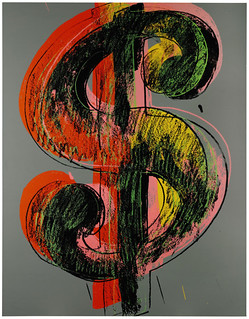
PREV ARTICLE
NEXT ARTICLE
FULL ISSUE
PREV FULL ISSUE
CAJORI ON THE ORIGIN OF THE DOLLAR SIGN
Pablo Hoffman forwarded this explanation of the history of the dollar sign taken from a 1929 book on the History of Mathematical
Notations. Thanks. For visual spice I added an Andy Warhol dollar sign. -Editor
Spanish pesos were also called piastres, Spanish dollars, and pieces of eight. (The piece of eight was so called because its value was eight reales. Some countries made one-real coins by slicing pieces of eight into eight sectors; the still-current U.S. slang "two bits" for a quarter of a dollar may refer to this, although "bit" denoting any small coin -- as in "threepenny bit" -- was already in use.) The coins were circulated in many parts of the world, much as U.S. dollars are today. The coins were so well known that, when the U.S. got around to issuing its own silver coinage (U.S. dollar coins first appeared in 1794), it simply replicated the Spanish unit's weight and hence value, and even one of its names; so it was natural to use the same symbol. Since three of the four names given above for the Spanish dollar start with p (and pluralize with s), it was natural for abbreviations like p and ps to be used. Sometimes ps was written s as P -- P with a superscript s. The superscript was a common way of rendering abbreviated endings of words -- we see vestiges of it today in the way some people write "10th". Now, what happens if you write P with a superscript s *fast*, because it's part of a long document that you have to hand-write because you can't wait for the typewriter to be invented, let alone the word-processor? Naturally, you join the letters. Well, now look at the top part of the resulting symbol. There's the $ sign! Reduce the P to a single stroke and you have the form of the $ with a double vertical; omit it altogether and you get the single vertical. And yes, both these forms are original. Cajori reproduces 14 $ signs from a diary written in 1776; 11 of them have the single stroke, which was the more common form to the end of the century, and 3 have the double stroke. Although the $ sign originally referred to a Spanish coin, it was the revolting British -> American colonists who made the transition from ps to the new sign. (This is apparently also why we write $1 instead of 1$; it mimics the British use of the pound sign.) So, while it did not originally refer to the U.S. dollar, the symbol does legitimately claim its origins in that country. To read the complete article, see:
I answered my own question by checking the E-Sylum archives - Eric Newman was well aware of this source when writing his 1993
paper, "The Dollar $ign: Its Written and Printed Origins" Eric added material Cajori did not know about, and corrected things
other people had written in their zeal to annoint other "creators" of the symbol. -Editor
To read the earlier E-Sylum articles, see:

Wayne Homren, Editor The Numismatic Bibliomania Society is a non-profit organization promoting numismatic literature. See our web site at coinbooks.org. To submit items for publication in The E-Sylum, write to the Editor at this address: whomren@gmail.com To subscribe go to: https://my.binhost.com/lists/listinfo/esylum All Rights Reserved. NBS Home Page Contact the NBS webmaster 
|
